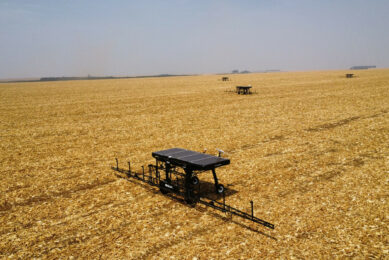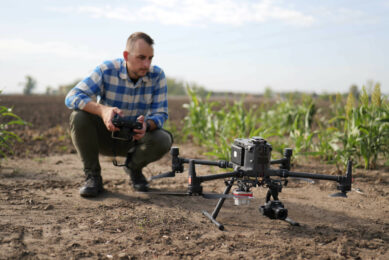Drones and AI in the battle against Alternaria in potato crops

By employing ultra-high-resolution drone imagery combined with AI, a new method has been developed for the early detection of Alternaria – a fungal pathogen (early blight) that can cause significant damage to potato crops by infecting the leaves, stems, and sometimes even the tubers. This breakthrough marks a significant advancement in precision agriculture, enabling growers to intervene more precisely and efficiently, resulting in healthier crops and a more sustainable agricultural practice.
“With this technology, we can detect the disease before it is visible to the naked eye, which can significantly increase the effectiveness of control measures”, explains researcher Jana Wieme. Jana Wieme conducted this research under the guidance of two supervisors and in collaboration with Belgian organizations IDLab (Sam Leroux), ILVO (Simon Cool), and the Bayer Forward Farming chair; Professor Jan Pieters (UGent) focuses on plant health and sustainable crop protection, while Prof. Wouter Maes (UGent) is an expert in precision agriculture and environmentally friendly farming techniques.
Specific form of AI
The approach utilizes a specific form of AI, a proprietary compact convolutional neural network, which can recognize patterns – in this case, small spots on infrared images – by learning from examples, much like the human brain learns from experiences. This enables the network to detect even the smallest indications of the disease before they are visible to the naked eye.
The team tested this model on datasets collected over multiple growing seasons. “What makes our research unique is that we repeated the trials for 4 different growing seasons, and our model also works on datasets it hasn’t been trained on. So, our model is already capable of being applied in practice. Moreover, our model achieves an accuracy comparable to current state-of-the-art models, but it is much faster and more efficient in processing the images,” emphasizes Wieme.
‘Disease maps’
The practical implications of this development are significant. Traditionally, the disease is controlled by regularly using crop protection chemicals. These chemicals can sometimes entail high costs and can be burdensome to the environment. The new method offers the possibility of detecting the disease early and locally, enabling a more targeted and therefore more sustainable use of resources.
Researcher Wieme explains, “This technology allows us to create detailed ‘disease maps’ of the fields. Farmers can use this information to treat only those parts of the field where the disease actually occurs.” This not only saves costs but also reduces the environmental impact of agricultural practices.
The research team is optimistic about the future applications of their work. “Although we have focused on Alternaria in potato fields, the methodology is broadly applicable for the detection of various diseases in different crops,” says Wieme. “This opens new doors to more efficient and sustainable agriculture.”
Join 17,000+ subscribers
Subscribe to our newsletter to stay updated about all the need-to-know content in the agricultural sector, two times a week.



